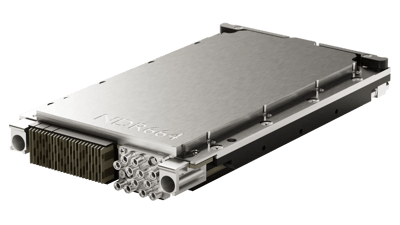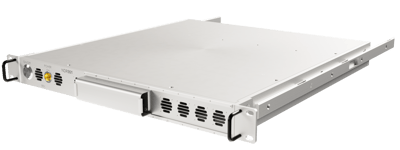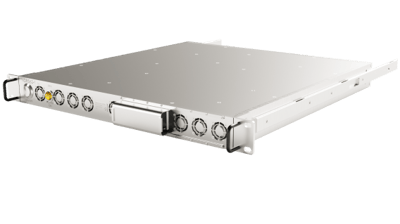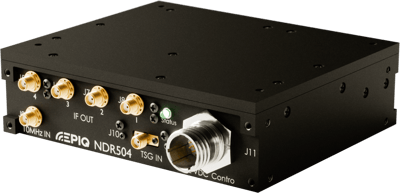Doing More With Less: The Evolution of the World’s Smallest Software-Defined Radio (SDR)
John Orlando
02/26/21

A few years back, we found ourselves exploring an interesting question: what kind of software-defined radio (SDR) module would be possible with a power budget of less than two watts for the entire system (flexible RF front end, flexible RF transceiver, FPGA, and Linux computer), while occupying less than one cubic inch in volume? Many of our customers have demanding requirements for low size, weight, and power (SWaP) RF solutions for applications that live in very small form factors such as handheld, remotely deployed sensors, unmanned aerial vehicles (UAVs), and everything in between. At the time, it was not clear if such a solution was even possible within the prescribed SWaP constraints. So our team at Epiq Solutions decided to dig in deeper to explore what happens when you push the boundaries of integration.
We’ve previously had success getting significant portions of an SDR system on a small form factor module, such as our Sidekiq Mini PCIe card which measures just 30 mm x 51 mm x 5 mm. But even there, the hardware is packed in fairly tight, and it doesn’t include the Linux computer.

Our original Sidekiq MiniPCIe card, released to the market in 2014
We knew a Mini PCIe card form factor would be a solid contender for a fully-integrated SDR since it is less than one cubic inch and has a max power consumption of 2.5 watts per the Mini PCIe card specification. This form factor is also widely used in a number of industries, which helps simplify the electrical/mechanical integration for customers. Still, with less than a half a cubic inch of total volume to work with, we would still need to figure out how to get a CPU, RAM, flash, and some form of usable I/O to access the system all onto the module, in addition to the RF hardware. With such limited PCB real estate and aggressive power consumption requirements, careful component selection to maximize integration would be imperative to a successful design.
The integration of a CPU, FPGA fabric, and standard I/O modules into a single chip solution is critical to unlocking a tiny integrated SDR module like the one we were contemplating. Xilinx has been pushing the envelope here with its Zynq® and Zynq® Ultrascale+ family of system-on-chip (SoC) products. In particular, their Xilinx Zynq® XC7Z010-2I is available in a 13 mm x 13 mm package, and combines a dual-core ARM Cortex A9 CPU running Linux, FPGA fabric, and plenty of I/O to support most embedded processing use-cases.


Xilinx Zynq 7010 is the smallest system-on-chip with dual-core ARM Cortex A9 CPUs + FPGA fabric (image courtesy of Xilinx, Inc)
Even with the Zynq, we still needed RAM, flash, and I/O to complete the digital portion of the SDR module. RAM chips come in a variety of packages, but the smallest commonly available package compatible with the Zynq SoC is a single-chip DDR3L measuring 8 mm x 10 mm that provides up to 512 MB of volatile memory. This is sufficient for most embedded applications, and fit reasonably well within our target size and power consumption budget.
The next digital component to address was the non-volatile flash memory. This one was much trickier since most embedded Linux systems rely on either a microSD card or eMMC memory to provide a substantial amount of non-volatile disk space to hold their Linux kernel + root filesystem with their applications. Unfortunately, the package size for either of these options was simply too large to fit on a Mini PCIe card with everything else needed. A microSD card measures 11 mm x 15 mm, with the requisite socket taking up slightly more space. A comparable solder-down eMMC card typically requires 11.5 mm x 13 mm, which is still fairly large. While either solution would have no issue providing many GB of non-volatile storage, there simply wasn’t space to accommodate the package with the area we wanted.

Comparison of non-volatile memory package sizes for storage
An alternate solution is to find a physically smaller non-volatile memory device that is compatible with the Zynq family of SoCs, and capable of being mounted as a standard storage device under Linux. Many Zynq systems utilize quad serial peripheral interface (QSPI) memory as their initial boot device, holding the bootloader and potentially the Linux kernel, with the root filesystem stored on a separate microSD card or eMMC device. However, it is also possible to include the root filesystem on the QSPI device as well, so that a single memory chip provides all the necessary non-volatile memory needed by the system. QSPI is available in a very small package size, measuring just 6 mm x 8 mm, which aligns well with our goals for this module. The only downside was that the memory capacity is also small by modern standards: the largest available memory density available in the 6 mm x 8 mm footprint is 128 MB (yes, that is megabyte, not gigabyte). While this may seem like a limiting factor, keep in mind that the design goal here is to minimize SWaP, and not necessarily run a complete graphical desktop Linux install such as Ubuntu or CentOS. In reality, for embedded Linux systems, 128 MB of storage is quite a bit of capacity. In our early prototyping of the proposed SDR system, we were able to get the bootloader, Linux kernel, and a reasonably capable Linux root filesystem to all fit within just 16 MB, leaving over 100 MB for user data and applications. So while more storage is always preferred, a small embedded Linux system can make due with 128 MB of non-volatile memory quite handily.
Last up for the digital requirements was the I/O. With a focus on the Mini PCIe form factor, all of our I/O would be going through the edge connector defined in the Mini PCIe spec. The Mini PCIe card spec defines both a PCIe x1 interface as well as a USB 2.0 interface (in addition to various GPIO) available at the edge connector. The Zynq 7010 SoC in the 13 mm x 13 mm package doesn’t expose PCIe due to the limited pins available on the package, but does provide USB 2.0 OTG. This USB 2.0 OTG interface provides both host and device capabilities for the proposed module, and is an ideal I/O interface for a SWaP-focused solution. Additionally, a serial console port and GPIO attached to both the CPU as well as the FPGA fabric can also be broken out for access via the edge connector of the Mini PCIe card, rounding out the typical I/O needed for an embedded Linux system.
With the digital sections reasonably well defined, the last critical hardware sections to work out was the RF front end and RF transceiver. We developed a number of different modules based on Analog Devices’ AD936x RFICs, which provides a complete RF-to-bits wideband transceiver in a 12 mm x 12 mm package. The AD9364 is a 1x1 RF transceiver that supports RF tuning from 70 MHz to 6 GHz, with sample rates up to 61.44 Msamples/sec. To ensure robust operation in real-world environments, an RF front end was also required, which includes RF pre-select filters, low noise amplifiers, and other hardware to connect the U.FL antenna ports to the RFIC. A high stability reference clock (such as a temperature compensated voltage controlled oscillator, or TCVCXO) was also a necessity to ensure stable RF operation. Finally, RF shielding around the entire RF section was critical to help reduce spurious signals and maximize performance of the system.

Block diagram of the Analog Devices' AD9364 RFIC (image courtesy of Analog Devices, Inc.)
So with some reasonable confidence that a fully integrated, complete SDR module should be possible to fit on a standard Mini PCIe card, our engineering team dug in to make it happen. The result of this effort was our Sidekiq™ Z2 SDR, the world’s smallest wideband RF transceiver with a complete Linux computer on a Mini PCIe card. This was, and remains today, a breakthrough solution for ultra-small form factor SDRs, requiring only an antenna and a 3.3V DC power supply to provide a complete standalone RF processing solution. The Z2 lives right at the edge of what’s possible in terms of integrating stand-alone SDR functionality on a single module.

The Sidekiq Z2 is the smallest wideband RF transceiver + Linux computer you can get in a production-ready module (RF shield cover removed)
Though radically small and with power consumption lower than anything else on the market, Sidekiq Z2 has been designed for demanding environments. It is ideally suited for small form factor applications where flexibility and energy efficiency are critical including handheld or mobile RF test and measurement, portable RF sensing, and wireless security monitoring.
Our goal with this project, as with everything we do, was to provide our customers with a solution that would allow them to focus on their application development instead of complicated RF development and system integration. Sidekiq Z2 isn’t just industrial-grade hardware. It also incorporates a comprehensive FPGA reference design and libsidekiq software API to simplify application development. For customers interested in a completely open source solution, there is a port of Analog Devices' IIO software which is also available for Sidekiq Z2.
Though Sidekiq Z2 pushes the boundaries of SDR in small form factors and low power consumption, the card provides a unique combination of RF flexibility, digital signal processing, and robust hardware to enable a number of real world use-cases. Here are a few examples where Sidekiq Z2 is being deployed today:
- Handheld RF Spectrum Analyzer: HTML5-based real-time RF spectrum analyzer that runs in its own local web server (web browser connects over USB from a host laptop/tablet/phone to display RF spectrum results, with no additional software to be loaded on the host device).
- Cellular Network Scanning Receiver: A low-SWaP, handheld 2G/3G/4G/5G cellular network survey solution to provide real-time signal quality measurements and decoded MIB/SIB broadcast information coming from nearby commercial cellular base stations.
- Long Range Mesh Network Radio Node: Spec-compliant 802.11b PHY transmit + receive solution capable of supporting the full range of data rates (1 Mbps, 2 Mbps, 5.5 Mbps, and 11 Mbps), with a custom mesh network layer implemented on top of this PHY in Linux.
- 4G LTE Device Detection: Detection of 4G LTE devices in railway deployments where cell phone usage is not allowed in the locomotive to prevent distraction and maximize safety.
- CubeSat RF Data Link: Flexible RF data link optimized for low size, weight, and power consumption to enable communications between a small form factor CubeSat satellite in low earth orbit and a groundstation
Sidekiq Z2 at a Glance
|
RF Tuning Range 70 MHz to 6 GHz |
Form Factor Mini PCIe card: 30 mm x 51 mm x 5 mm |
CPU Dual-core ARM Cortex A9 |
|
Flash Memory 128 MB |
RAM 512 MB of DDR3L |
Component Temperature Rating -40˚C to +85˚C |
|
Sample Rate Up to 61.44 Msps |
Typical Power Consumption Under 2W |
Filter Bank Four band Rx pre-select |
And while a single Sidekiq Z2 is compact in size and low in power consumption, the impact that this level of integration can have to enable new classes of flexible RF solutions for our customers has been substantial. Our production team is cranking out thousands of SDRs every year to deliver to customers all over the world. Below is a photo from a production build last year, showcasing a batch of 120 Sidekiq Z2 SDR cards (from a larger order of 500 cards), occupying only a few square feet. Each SDR goes through a complete automated calibration and testing process ahead of getting packaged up for shipping by our production team.

Being curious has always been at the center of innovation. As the trajectory of evolving defense-focused mission requirements aims toward ever-smaller technology, we are challenged to deliver constant innovation. With Sidekiq Z2, we were able to help our customers reduce their RF product development cycle, while advancing the state of the art in small form factor SDR. From our perspective, that is a win for everyone.
To learn more about how less is more in the real-world of SDRs, read about our Mini PCIe in space. As always, if you want to speak to us directly about your RF needs, we’d love to hear from you.
SHARE
Tags
STAY INFORMED
Stay up to date with the latest Epiq news, product releases, and more.












.webp?length=400&name=Cyber-Radio-NDR585%20(3).webp)


















.webp?width=70&height=70&name=Vector%20(1).webp)


